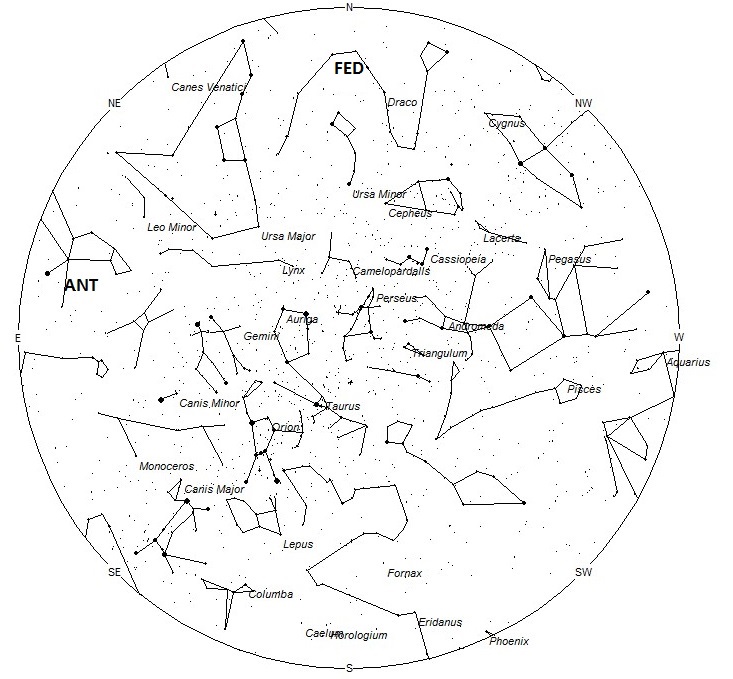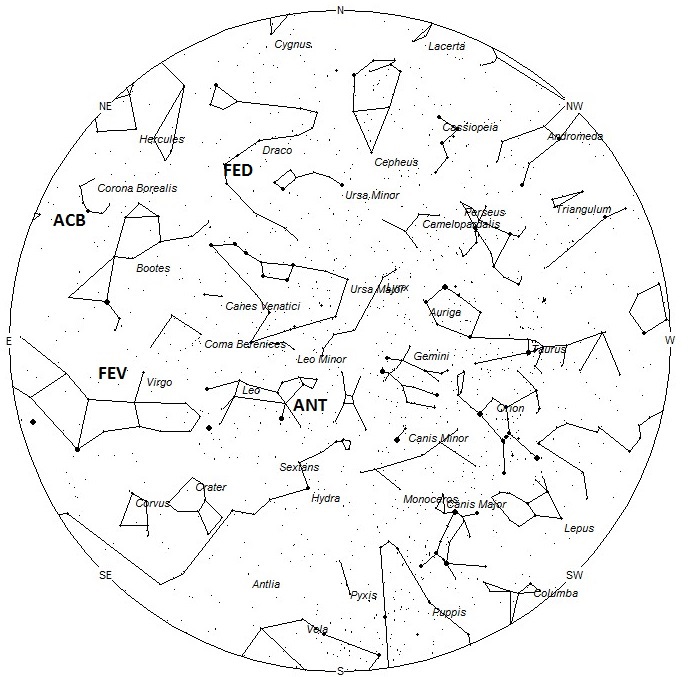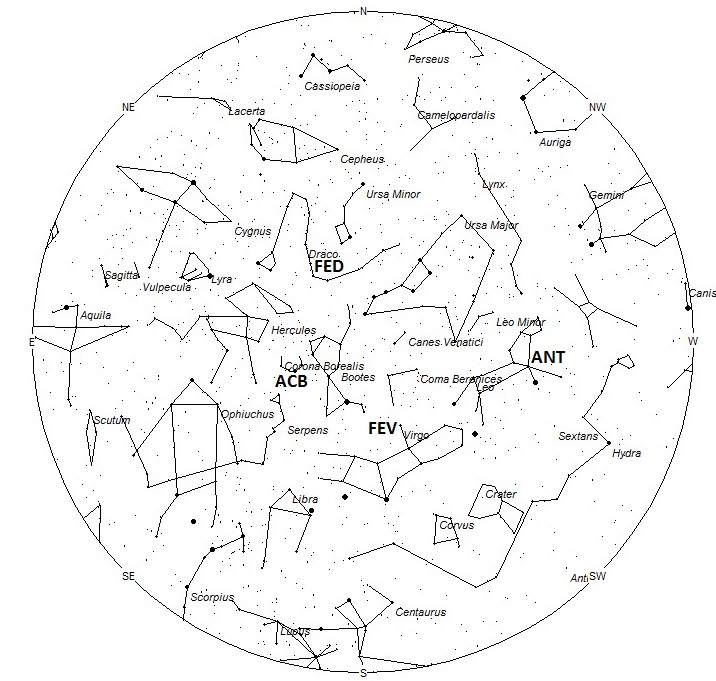
February offers the meteor observer in the northern hemisphere a couple of weak showers plus falling sporadic rates. This may not seem too exiting but you never know when surprises are in store. An errant earthgrazer from the Centaurid complex may shoot northward. Better yet, a bright fireball may light up the sky. February is the start of the fireball season, when an abundance of fireballs seem to occur. This lasts well into April and seems to occur mostly during the early evening hours.
Observers in the southern hemisphere are treated to the Alpha Centaurid peak on the 8th plus the entire Centaurid complex of radiants is active all month long. This is reminiscent of the summer activity seen from the northern hemisphere in the Milky Way constellations of Perseus and Auriga during August and September. Sporadic rates also peak this month south of the equator this month adding to the celestial show.
During this period the moon reaches its last quarter phase on Monday February 1st. On that date the moon will be located 90 degrees west of the sun and will rise between midnight and 0100 local standard time (LST) as seen from most of North America. As the week progresses the waning crescent moon will rise approximately 45 minutes later with each passing night, allowing longer intervals of dark skies for the meteor observer. The estimated total hourly meteor rates for evening observers this week is near 3 no matter your location. For morning observers the estimated total hourly rates should be near 9 as seen from mid-northern latitudes (45N) and 10 as seen from tropical southern locations (25S). The actual rates will also depend on factors such as personal light and motion perception, local weather conditions, alertness and experience in watching meteor activity. Morning rates are slightly reduced this week due to moonlight. Note that the hourly rates listed below are estimates as viewed from dark sky sites away from urban light sources. Observers viewing from urban areas will see less activity as only the brightest meteors will be visible from such locations.
The radiant (the area of the sky where meteors appear to shoot from) positions and rates listed below are exact for Saturday night/Sunday morning January 30/31. These positions do not change greatly day to day so the listed coordinates may be used during this entire period. Most star atlases (available at science stores and planetariums) will provide maps with grid lines of the celestial coordinates so that you may find out exactly where these positions are located in the sky. A planisphere or computer planetarium program is also useful in showing the sky at any time of night on any date of the year. Activity from each radiant is best seen when it is positioned highest in the sky, either due north or south along the meridian, depending on your latitude. It must be remembered that meteor activity is rarely seen at the radiant position. Rather they shoot outwards from the radiant so it is best to center your field of view so that the radiant lies at the edge and not the center. Viewing there will allow you to easily trace the path of each meteor back to the radiant (if it is a shower member) or in another direction if it is a sporadic. Meteor activity is not seen from radiants that are located below the horizon. The positions below are listed in a west to east manner in order of right ascension (celestial longitude). The positions listed first are located further west therefore are accessible earlier in the night while those listed further down the list rise later in the night.
These sources of meteoric activity are expected to be active this week.
The center of the large Anthelion (ANT) radiant is currently located at 09:36 (144) +13. This position lies in western Leo, 8 degrees northwest of the 1st magnitude star known as Regulus (Alpha Leonis). Due to the large size of this radiant, Anthelion activity may also appear from Cancer, northwestern Hydra, and Sextans as well as western Leo. This radiant is best placed near 0100 local standard time (LST), when it lies on the meridian and is located highest in the sky. Rates at this time should be near 2 per hour as seen from the northern hemisphere and 1 per hour from south of the equator. With an entry velocity of 30 km/sec., the average Anthelion meteor would be of slow velocity.
The February Epsilon Virginids (FEV) were discovered by Kathryn Steakly & Dr. Peter Jenniskens using data from CAMS and SonotaCo. This shower is active from January 29-February 9, with maximum activity occurring on February 4th. At maximum the radiant is located at 13:24 (201) +11, which places it in northern Virgo, 4 degrees east of the 3rd magnitude star known as Vindemiatrix (Epsilon Virginis). These meteors would be best seen near 0400 LST when the radiant lies highest above the horizon. Rates at maximum would be expected to be near 1 per hour during the last dark hour before dawn. These meteors are equally well seen from either hemisphere. These meteors encounter the atmosphere at 64 km/sec., which would produce mostly swift meteors.
The Alpha Centaurids (ACE) are active from January 28 though February 21, with maximum activity occurring on February 8. The radiant is currently located at 13:32 (203) -57. This position lies in southeastern Centaurus between the bright stars Mimosa (Beta Crucis) and Epsilon Centauri. Due to the southern declination of this radiant, these meteors are not well seen in the northern hemisphere. Current rates would be near 1 per hour as seen from the southern hemisphere and less than 1 from the northern hemisphere. These meteors are best seen near 0500 LST when the radiant lies highest above the horizon. At 56 km/sec. the Alpha Centaurids would produce mostly swift meteors.
The Alpha Coronae Borealids (ACB) were discovered by John Greaves using data from SonotaCo. These meteors are active from January 27-February 5, with maximum activity occurring on the January 28. The radiant is currently located at 15:46 (236) +23. This position lies in northern Serpens Caput, 4 degrees southeast of the 2nd magnitude star known as Alphecca (Alpha Coronae Borealis). These meteors would be best seen during the last dark hour before dawn when the radiant lies highest above the horizon in a dark sky. Hourly rates would most likely be near 1 per hour this weekend, falling to less than 1 the remainder of the week. These meteors encounter the atmosphere at 57 km/sec., which would produce meteors of medium-fast velocity.
The February Eta Draconids (FED) were discovered by Dr. Peter Jenniskens and Peter Gural using data from the first CAMS network in northern California. These meteors are active on only 3 nights, February 3-6. The maximum occurs on February 4 when the radiant is located at 15:59 (240) +61. This position lies in central Draco, 3 degrees west of the 3rd magnitude star known as Eta Draconis. These meteors are best seenduring the last dark hour before dawn when the radiant lies highest above the horizon in a dark sky. Expected rates would be less than 1 per hour, even at maximum. These meteors are difficult to see from the southern tropics and impossible to see from latitudes south of 30S. At 32 km/sec. the February Eta Draconids produce mostly medium-slow meteors.
As seen from the mid-northern hemisphere (45N) one would expect to see approximately 6 sporadic meteors per hour during the last hour before dawn as seen from rural observing sites. Evening rates would be near 2 per hour. As seen from the tropical southern latitudes (25S), morning rates would be near 8 per hour as seen from rural observing sites and 3 per hour during the evening hours. Locations between these two extremes would see activity between the listed figures.
| SHOWER | DATE OF MAXIMUM ACTIVITY | CELESTIAL POSITION | ENTRY VELOCITY | CULMINATION | HOURLY RATE | CLASS |
| RA (RA in Deg.) DEC | Km/Sec | Local Standard Time | North-South | |||
| Anthelions (ANT) | – | 09:36 (144) +13 | 30 | 01:00 | 2 – 1 | II |
| February Epsilon Virginids (FEV) | Feb 04 | 13:04 (201) +11 | 64 | 04:00 | <1 – <1 | IV |
| Alpha Centaurids (ACE) | Feb 08 | 13:32 (203) -57 | 56 | 05:00 | <1 – 1 | II |
| Alpha Coronae Borealids (ACB) | Jan 28 | 15:46 (236) +23 | 57 | 07:00 | 1 – <1 | IV |
| Feb. Eta Draconids (FED) | Feb 04 | 15:59 (240) +61 | 32 | 07:00 | <1 – <1 | IV |
 American Meteor Society
American Meteor Society



Hi, I was wondering if anyone has reported a meteor for Feb. 2 2016. I live in Regina , Saskatchewan, Canada, and was walking my dog at 7:05 A.M. and straight south of the city a huge fire ball lite the sky up.
I wish I had a go pro because it was amazing.
Please let me know what you find, as I have been searching and can not believe no one else has seen it. Should have been seen in Montana or possible North dakota.
Thank-you
Rob